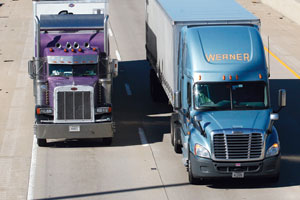Trucking’s 2Q Earnings Expected to Climb on Higher Rates, Declining Fuel Prices

Rising rates and falling fuel prices should drive higher second-quarter earnings in the trucking sector when results begin to roll in this week, analysts said.
A parade of fleets’ financial results begins with J.B. Hunt Transport Services Inc. and Marten Transport Ltd., which are expected to have a strong performance and set the pace for the sector. Hunt ranks No. 3 on the Transport Topics Top 100 list of U.S. and Canadian for-hire carriers, Marten ranks No. 48.
Truckload earnings are poised to rise more than 20% on average, with 13 increases and two declines, based on Transport Topics’ analysis of earnings estimates compiled by Bloomberg News.
Five of six fleets with less-than-truckload freight offerings should improve results. Likewise, five of six logistics companies also are likely to do better financially.
Stronger profits are expected, even though freight demand has dropped off, as shown in American Trucking Associations latest truck tonnage report. Its index rose just 1.8% in May, the smallest in more than two years.
As industry volume eased, trucking supply and demand now have come into balance, Cowen and Co. analyst Jason Seidl told TT on July 7. That’s in sharp contrast to last year’s second quarter, when capacity was squeezed amid a stronger U.S. economy and freight that was held over from the severe 2014 winter.
“Pricing is still strong,” Seidl said, referring to truckload rates that have climbed 5% or more industrywide this year.
“Shippers have short memories — they’re paying more because of what happened last year,” Seidl said, explaining that they’re willing to swallow increases to get trucks.
In addition, he said, the 26% second-quarter diesel price drop below 2014 levels will shave expenses that typically are fleets’ second-biggest cost after wages.
As in recent quarters, No. 46 Covenant Transportation Group Inc. is expected to have the largest percentage growth in earnings, with profit due to more than double to about $8.4 million from net income of $3.8 million a year ago.
No. 16 Werner Enterprises Inc.’s earnings are poised to rise 20% or more, largely because of the carrier’s success in raising rates as much as 7% year-over-year on over-the-road business, Thom Albrecht of BB&T Capital Markets said in a report. Werner reported 2014 second-quarter net income of $25.6 million.
Lower earnings are expected at No. 39 Heartland Express Inc. and No. 27 Universal Truckload Services Inc., while No. 36 Quality Distribution Inc.’s earnings are expected to be little changed.
In a separate report, Albrecht said Hunt should have a “solid” quarter, due in part to intermodal price increases that may have caused some market share loss. Based on the Bloomberg average estimate, Hunt earnings could climb 14% and top $105 million. Hunt last week was added to the Standard & Poor’s 500
On the LTL side, the only expected decline is 11% at No. 4 Con-way Inc., which reported 2014 second-quarter net income of $53.7 million. Some analysts last month speculated that profit growth was lagging at Con-way Freight, the largest unit. Its president left the company in June to take a CEO post at a logistics operator.
LTL carrier YRC Worldwide Inc., No. 5, is expected to reverse a year-earlier loss of $4.9 million and earn about $7 million.
Elsewhere in trucking, profit is expected to rise 3% at No. 1 UPS Inc. to $1.15 billion. Leasing specialist No. 13 Ryder System Inc.’s earnings are pegged to rise about 13% to nearly $86 million as business improves in that sector.
Earnings growth is forecast, even though trucking stocks continued to tumble last week. As of July 8, trucking shares measured by the Standard & Poor’s Supercomposite Trucking Index hit a 2015 low, dropping nearly 13% since January.
“Second-quarter earnings expectations aren’t hurting the stock prices now,” Seidl said. “It is the future. Stocks are under pressure because of investors’ concerns about the economy and the prospect that pricing and earnings could weaken.”
Less-than-truckload is one sector where weaker earnings results could appear first, Seidl said, because “we are starting to see cracks” in their pricing growth.
Most LTL operators have sustained profit growth so far in 2015 by holding on rate increases despite underlying weakness in manufacturing and the U.S. economy, he said.
Others are more optimistic about the second-half freight market.
“There are a few nascent signs that the soft patch may be bottoming,” Albrecht said, in a report that labeled the first half “disappointing.”
Specifically, he cited stronger June jobs, manufacturing, consumer spending and housing reports that could brighten second-half prospects.
But analyst Benjamin Hartford of Robert W. Baird & Co. noted divergent trends in transport stocks.
On one hand, he said, earnings at brokers such as C.H. Robinson Worldwide Inc. (up 7%) and Echo Global Logistics (up 14%) could beat forecasts. Among logistics operators, the Hub Group’s 15% drop is the only expected decline.
C.H. Robinson is No. 4 on the Transport Topics Logistics 50 list, Echo Global is No. 45 and Hub is No. 31.
Year-ago second-quarter net income for Robinson was $118.6 million; and $5.1 million for Echo; Hub’s was a record $18.7 million.
Hartford believes LTL and rail earnings could miss expectations. Rail earnings are being pressured by a traffic decline in nearly every commodity other than intermodal.




